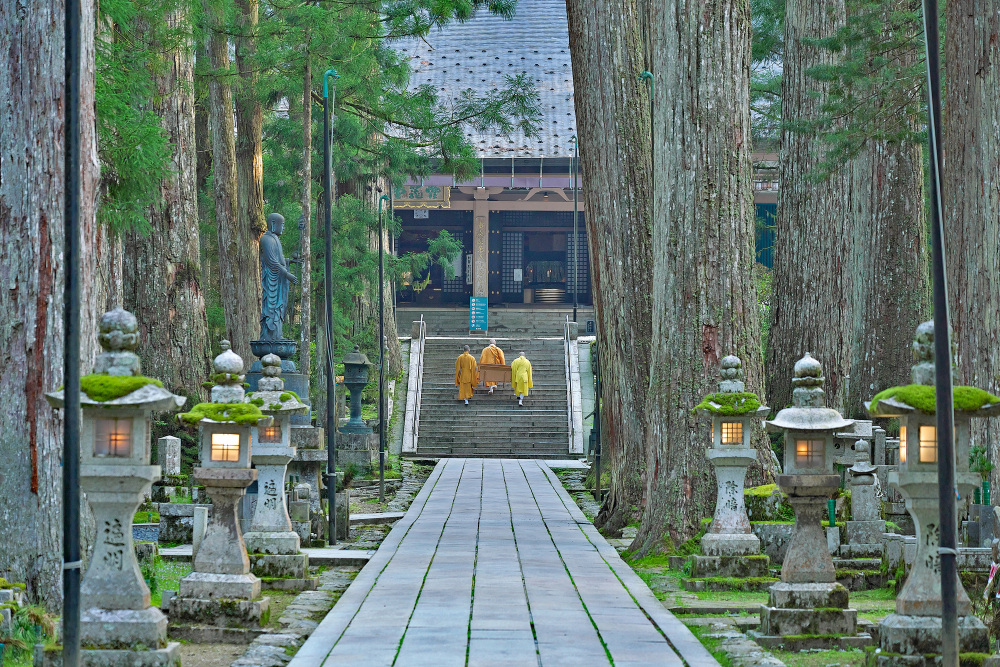A Spiritual Journey to Kumano Kodo and Koyasan

Wakayama is known as the spiritual center of Japan because the Kumano Kodo Pilgrimage Routes and Koyasan—a mountaintop temple complex—lie within the prefecture's borders. Visitors to these areas can enjoy an enhanced travel experience through Buddhist temple stays, spiritual walks, and involvement in traditional Buddhist practices.
OVERVIEW
· Stay overnight in the mountaintop temple complex, Koyasan
· Visit Japan's largest cemetery, Okuno-in
· Discover the daily practices of a Koyasan Buddhist monk
· Walk sections of the Nakahechi route on the ancient Kumano Kodo
Koyasan—a Mountain of Temples
Koyasan is a sprawling mountaintop temple complex of 117 Buddhist temples founded by Kukai (Kobo Daishi) over 1,200 years ago. The area is much more than a sightseeing spot. Visitors to Koyasan can engage in a much deeper travel experience through shukubo, or Buddhist temple stays, and immersive activities. As well as learning about traditional Buddhist practices, travelers can wander through Okuno-in, a large cemetery that is home to thousands of departed souls.
Who was Kobo Daishi?
Kukai—posthumously known as Kobo Daishi (774-835)—was a Japanese Buddhist monk and founder of Shingon Buddhism.
Okuno-in
The mausoleum of Kobo Daishi is in Okuno-in, the largest cemetary in Japan, and the holiest location in Koyasan. Kobo Daishi lies in eternal meditation here, waiting for Miroku Nyorai, Buddha of the Future. There are more than 200,000 tombstones and commemorative monuments in the cemetery, and visitors can wander through the spiritual spot on a cedar-lined path. Be aware that no food, drink, or photography are allowed beyond the Gobyobashi Bridge.
Shukubo
Shukubo, or temple stays, offer visitors a one-of-a-kind experience. By staying overnight at a temple, you can gain insight into the lives of the monks that reside there. Guests stay in traditional Japanese rooms with futons and tatami mats, and have opportunities to pray with the monks in the mornings or late afternoons. Enjoy Buddhist cuisine for dinner or take part in shakyo, or sutra copying, activity (the activities offered depend on the temple). Around 50 Koyasan temples offer shukubo accommodation.
How to get to Koyasan from Tokyo or Osaka

・Koyasan is accessible by rail. The shinkansen from Tokyo to Shin-Osaka takes around 2 hours 30 minutes.
・Take the Midosuji Line of Osaka City Subway from Shin-Osaka to Namba to connect with the Nankai Koya Line.
・At the Gokurakubashi stop, change to the Nankai Cable Car to Koyasan.
Column
Travel Tips
Kyoto to Koyasan
The Kyoto-Koyasan Direct Highway bus offers easy travel between Kyoto and Koyasan.
Koyasan to Kumano
Board the Koyasan-Kumano Discovery Bus to get to Kumano from Koyasan (operates from April to November).
Kumano Kodo Pilgrimage Routes
The Kumano Kodo Pilgrimage Routes snake through the verdant forest of the Kii Peninsula, leading to the Kumano Sanzan—the grand shrines of Kumano. Walkers and hikers can choose from several routes, ranging in difficulty from easy to arduous. The most well-trodden route is the Nakahechi that runs from Tanabe to Kumano Nachi Taisha Grand Shrine—one of the Kumano Sanzan. Other routes include the Kohechi (challenging), and the Iseji Route (moderate). Discover the most suitable route for you by browsing the itinerary below.
Kumano Kodo Nakahechi Route
The Nakahechi is the most popular route among the Kumano Kodo Pilgrimage Routes. However, this doesn't mean that it is an easy hike.
The full route is a five-day journey (although you can choose to walk a section of it) and is physically demanding. Hikers will encounter twisting mountain paths, steep slopes, and steps. While the Nakahechi Route might be taxing on the body, it is rewarding for the soul. Before embarking, assess your health and prepare all necessary items.
Kumano Sanzan
The Kumano Sanzan are the grand shrines of Kumano and the ultimate destination for pilgrims along the Kumano Kodo Pilgrimage Routes. Each shrine has distinct characteristics, from the sweeping cypress roofs of Kumano Hongu Taisha to the thundering waterfall that forms the backdrop to Kumano Nachi Taisha.
Kawayu Onsen
Kawayu Onsen is one of three onsen (hot spring) hamlets that make up the Hongu Onsen-kyo—an area of hot spring hotels in central Wakayama. The cozy onsen hotels at Kawayu Onsen are clustered on the banks of the Kumano River.
The main winter attraction at Kawayu Onsen is the Senninburo—a huge onsen bath that is part of the river. The area is easily accessible by bus from the Kumano Kodo trails and Kumano Hongu Taisha Grand Shrine.
How to get to Kumano from Tokyo or Osaka

・Access the Kumano area from Tokyo by riding the shinkansen to Nagoya (around 1 hour 50 minutes) before changing to a Nanki express train to Shingu—a further 3 hours 30 minutes.
・From Osaka, take the Kuroshio limited express from Shin-Osaka to Kii-Tanabe. The 2-hour trip is a scenic journey that hugs the Wakayama coastline.








